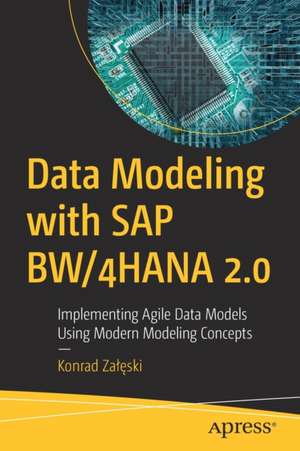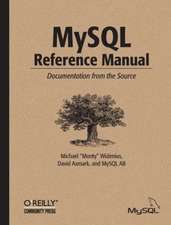Data Modeling with SAP BW/4HANA 2.0: Implementing Agile Data Models Using Modern Modeling Concepts
Autor Konrad Zaleskien Limba Engleză Paperback – 19 aug 2021
Gain practical guidance for implementing data models on the SAP BW/4HANA platform using modern modeling concepts. You will walk through the various modeling scenarios such as exposing HANA tables and views through BW/4HANA, creating virtual and hybrid data models, and integrating SAP and non-SAP data into a single data model.
Data Modeling with SAP BW/4HANA 2.0 gives you the skills you need to use the new SAP BW/HANA features and objects, covers modern modelling concepts, and equips you with the practical knowledge of how to use the best of the HANA and BW/4HANA worlds.
What You Will Learn
Data Modeling with SAP BW/4HANA 2.0 gives you the skills you need to use the new SAP BW/HANA features and objects, covers modern modelling concepts, and equips you with the practical knowledge of how to use the best of the HANA and BW/4HANA worlds.
What You Will Learn
- Discover the new modeling features in SAP BW/4HANA
- Combine SAP HANA and SAP BW/4HANA artifacts
- Leverage virtualization when designing and building data models
- Build hybrid data models combining InfoObject, OpenODS, and a field-based approach
- Integrate SAP and non-SAP data into single model Who This Book Is For
BI consultants, architects, developers, and analysts working in the SAP BW/4HANA environment.
Preț: 302.01 lei
Preț vechi: 377.52 lei
-20% Nou
Puncte Express: 453
Preț estimativ în valută:
57.79€ • 60.61$ • 48.11£
57.79€ • 60.61$ • 48.11£
Carte disponibilă
Livrare economică 11-25 martie
Preluare comenzi: 021 569.72.76
Specificații
ISBN-13: 9781484270882
ISBN-10: 1484270886
Pagini: 200
Ilustrații: XII, 273 p. 211 illus.
Dimensiuni: 155 x 235 mm
Greutate: 0.44 kg
Ediția:1st ed.
Editura: Apress
Colecția Apress
Locul publicării:Berkeley, CA, United States
ISBN-10: 1484270886
Pagini: 200
Ilustrații: XII, 273 p. 211 illus.
Dimensiuni: 155 x 235 mm
Greutate: 0.44 kg
Ediția:1st ed.
Editura: Apress
Colecția Apress
Locul publicării:Berkeley, CA, United States
Cuprins
Chapter 1: Modeling objects.- Chapter 2: Publishing external data in BW4HANA.- Chapter 3: Creating virtual BW4HANA model.- Chapter 4: Converting virtual structures into persistent BW4HANA model.- Chapter 5: Creating hybrid data model in BW4HANA.- Chapter 6: Combining SAP and non-SAP data into single data model.
Notă biografică
Konrad Załęski graduated from Warsaw University of Technology getting his master’s degree in management. After finishing his studies, he continued his education and completed two postgraduate courses in management information systems (Microsoft) and integrated information systems (SAP).
Konrad gained his experience by delivering business intelligence solutions for multiple global corporations. The majority of the projects from his portfolio were implemented on top of the SAP HANA, SAP BW/4HANA, and Microsoft BI platforms. He is also an active contributor and publisher in the SAP community.
Konrad gained his experience by delivering business intelligence solutions for multiple global corporations. The majority of the projects from his portfolio were implemented on top of the SAP HANA, SAP BW/4HANA, and Microsoft BI platforms. He is also an active contributor and publisher in the SAP community.
Textul de pe ultima copertă
Gain practical guidance for implementing data models on the SAP BW/4HANA platform using modern modeling concepts. You will walk through the various modeling scenarios such as exposing HANA tables and views through BW/4HANA, creating virtual and hybrid data models, and integrating SAP and non-SAP data into a single data model.Data Modeling with SAP BW/4HANA 2.0 gives you the skills you need to use the new SAP BW/HANA features and objects, covers modern modelling concepts, and equips you with the practical knowledge of how to use the best of the HANA and BW/4HANA worlds.
You will:
You will:
- Discover the new modeling features in SAP BW/4HANA
- Combine SAP HANA and SAP BW/4HANA artifacts
- Leverage virtualization when designing and building data models
- Build hybrid data models combining InfoObject, OpenODS, and a field-based approach
- Integrate SAP and non-SAP data into single model
Caracteristici
Understand how to leverage virtualization Discover hybrid modeling scenarios Integrate external sources with SAP data






















